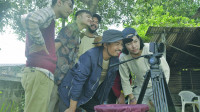Entertainment
The Guru of Gurukul
Sunil Pokharel is considered one of the pioneers of modern Nepali theatre.
You’ve been away from theatre for three years. Why did you choose Rashomon to make your way back?
Well, I had transcribed the story in 1985 because back then, when I was still a student at the National School of Drama in New Delhi, it was one of my favourite stories. Towards the end of last year, I’d started telling people that I wanted to stage it, and my student, Rajan Khatiwada, encouraged me to go for it. So I went through what I had transcribed, but because I found that the language was very weak, I rewrote it. Basically, I wanted to do this because I think the story is very good.
What was it like to be directing drama again after having been away for three years?
(Chuckles) Before the drama was staged, I was really nervous, as I always am. However, I’m glad I jumped in because I am getting positive feedback from the audiences. But working on stage didn’t feel any different from how things used to be before because I am working with old students of mine; they have all been very cooperative throughout.
How did you spend those three years?
Well, those three years were the most frustrating years of my life. I didn’t come out of the house, and I’d read four to five books every day–I read almost all the contemporary Nepali literature works that were published then, along with Hindi and English literature; and I’d just eat and sleep, and drink more than I used to. But with my delving back into work, the drinking is taking care of itself.
The Aarohan group came together in 1982. And you all were trying stage works that questioned the Panchayat regime; and you stayed the course all the way through Jana Andolan II.
You were more or less a political outfit, the main focus of your plays was to make people think about their rights and the lack thereof; now that the situation has changed, what will be the content of your dramas in the coming days?
If you look at what’s happening, you could say that there needs to be more changes around here; the country is still in its transitional phase. To be sure, things are, in a way, utterly different compared to the Panchayat days. And yes, post-1990, we sort of stagnated for a decade because we didn’t know how to reorient ourselves to the new democratic era. But around 2002, when democracy was under siege again, we established Aarohan Gurukul. It wasn’t easy finding a venue for ourselves and we had to build everything from the ground up, but with the help of people like Keshav Sthapit, former mayor of Kathmandu Municipality, we were able to get going. As for the content of our plays? As I already mentioned, the country is in a transitional phase, and I can’t exactly say how we will tackle the issues of the day.
How about Forum theatre and the kinds of street dramas that Aarahon used to do? How have you been working with those formats?
Gurukul has already worked with 40 different drama groups in various parts of the country, and these groups have been active even in remote districts such as Doti, Humla and Taplejung: for the most part, they adopt the techniques of Forum theatre to get the spectators involved in their plays. Since its inception, Gurukul has produced 17 artistes, and most of them are doing exceptionally well.
You have devoted more than three decades of your life to theatre and you’ve directed around 40 dramas already. What does direction mean for you?
A director has to understand the core meaning of the play he is working with. He has to understand, as much as he can, the playwright’s intent, but he also needs to filter the work through his own experiences. I’d say that I view directing as an exercise in problem-solving.
Where do you think Nepali theatre will be in ten years? What’s your take on how things are playing out at present?
I think the future is very bright, because many emerging youths have shown an interest in theatre and the number of theatre group is also gradually increasing. For example, Anup Baral has set up the Actor’s Studio; Rajan Khatiwada is running Mandala Theatre; Ghimerey Yubraj is running Shilpee Theatre; and they are mostly playing to packed houses. That is a positive sign.
My only concern is that this growth is still Kathmandu-centric. Why aren’t schools sprouting in Lalitpur, Bhaktapur and Kirtipur? I also believe that in these places, the artistes must perform the dramas in their own language; that would help them preserve their culture and language. We have already talked with the youth of Kritipur to set up a theatre in their area. I guess that will take place in the near future.
You have also played worked in films such as Balidan, Acharya, Chakdkey and the upcoming Banful. What is the difference between working in theatre and film?
I consider theatre to be my profession, and even if I were not to do anything more than that in life, I’d be happy. I worked in movies mostly because my friends asked me to be involved.
How are the artistes who’ve made the leap from theatre to film faring?
Most theatre artistes who’ve entered the film industry have done relatively well. Saugat Malla, Daya Hang Rai and Rajan Khatiwada have, for example, really shone. Financially too, it looks like they’ll be able to sustain themselves. Furthermore, they are getting the exposure that’s impossible to get from theatre alone.




 19.12°C Kathmandu
19.12°C Kathmandu









